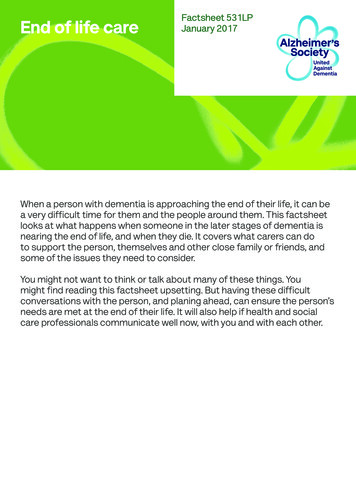
Transcription
End of life careFactsheet 531LPJanuary 2017When a person with dementia is approaching the end of their life, it can bea very difficult time for them and the people around them. This factsheetlooks at what happens when someone in the later stages of dementia isnearing the end of life, and when they die. It covers what carers can doto support the person, themselves and other close family or friends, andsome of the issues they need to consider.You might not want to think or talk about many of these things. Youmight find reading this factsheet upsetting. But having these difficultconversations with the person, and planing ahead, can ensure the person’sneeds are met at the end of their life. It will also help if health and socialcare professionals communicate well now, with you and with each other.
2 End of life careContentsnn Planning for the end of lifennPalliative and end of life carennDementia as a life-limiting illnessnnRecognising when someone is reaching the end of their lifennCommunicationnnPhysical needsnnMaking decisionsnnPsychological, cultural, religious and spiritual needsnnPlace of deathnnSupport for carers, family and close friendsnnAfter the person has diednnOther useful organisations.
3 End of life careEnd of life carePlanning for the end of lifePlanning for the end of life is important for anyone who has a life-limitingcondition. For a person with dementia it is important to try and havethese conversations as early as possible, while they can make decisionsfor themselves. If they don’t feel ready to think about the future at thistime, getting to know their values, wishes and beliefs more generally canhelp in the future when decisions need to be made on their behalf (see‘Making decisions’ below). There is more on making choices about futurecare (known as ‘advance care planning’) in factsheet 472, Lasting power ofattorney, and factsheet 463, Advance decisions and advance statements.Palliative and end of life carePalliative care is for anyone diagnosed with a life-limiting illness, includingdementia. It focuses on maintaining a person’s quality of life by relievingdiscomfort or distress (whatever the cause). Someone can receivepalliative care for several years and it may be offered alongside othertreatments, especially in the earlier stages of dementia. Any palliative carein place will continue alongside end of life care.End of life care aims to support someone in the later stages of a lifelimiting condition to live as well as possible until they die. It also aimsto support family and carers during this time and after the persondies. End of life care may last for weeks, months or occasionally years– it is often difficult to know exactly when a person with dementia isapproaching the end of their life.
4 End of life careEnd of life care should support the person to live as well as possible untilthey die. It supports all aspects of their wellbeing, especially:nntheir physical needs (including pain relief and management of othersymptoms)nnhow they are feelingnntheir relationships with othersnntheir spiritual beliefs and needs.For many people a ‘good death’ means:nnbeing treated with compassion and respectnnbeing kept clean, comfortable and free from distressing symptomsnnbeing in a familiar place surrounded by those close to them.End of life care for a person with dementia can involve a number ofdifferent professionals working together, including the GP, communitynurses, social workers or care home staff. Palliative care professionals ata local hospice or hospital may give specialist input if this is needed. Thisteam of professionals should keep you updated as the person’s conditionchanges and involve you in any decisions.The person should always have an up-to-date care plan that includes endof life plans and is shared with those involved in the person’s care. Someareas have special staff who co-ordinate end of life care for people withdementia. Ask the GP, community nurse or local hospice (if you have one)about what is available in your area.
5 End of life careDementia as a life-limiting illnessDementia is a life-limiting illness, but it is very difficult to know how longsomeone with dementia will live for. If a person also has another lifelimiting illness (such as cancer), it is often easier to know how quickly theircondition will get worse. A person may die from another condition at anystage of having dementia. Someone in the later stages of dementia whodoes not have another life-limiting illness gets worse slowly over manymonths. They gradually:nnbecome more frailnnhave more frequent falls or infectionsnnbecome less mobilennsleep morenneat and talk less.A person in the later stages of dementia may have symptoms that suggestthat they are close to death, but actually live with these symptoms formany months. This uncertainty makes it very difficult to plan and putthings in place for the end of someone’s life.For someone in the later stages of dementia, the most commonimmediate cause of their death is an infection such as pneumonia. At thispoint, the person is likely to be much frailer and have a weaker immunesystem, so is at greater risk of developing infections, which can last for along time. There are changes that are likely to happen when the personis within a few days or hours of dying (see ‘Recognising when someoneis reaching the end of their life’ below). Some of these changes may bedistressing, but health and social care professionals can reassure you thatthe person is not suffering.
6 End of life careRecognising when someone is reaching the end of their lifeIt is important to know when a person with dementia is nearing the endof their life because it can help in giving them the right care. However itcan be difficult to know when this time is. This uncertainty can have a bigimpact on how the person’s family feel, and may also affect how they feelthemselves. There are symptoms in the later stages of dementia thatcan suggest the person is reaching the final stage of their illness.These include:nnspeech limited to single words or phrases that may not make sensennneeding help with most everyday activitiesnneating less and having difficulties swallowingnnbowel and bladder incontinencennbeing unable to walk or stand, problems sitting up and controlling thehead, and becoming bed-bound.It is likely that a person with dementia is nearing the end of their life if theyhave these symptoms, along with other problems such as frailty, infectionsthat keep coming back, and pressure ulcers (bedsores). For moreinformation about pressure ulcers see factsheet 512, Pressure ulcers(bedsores).
7 End of life careAs someone’s condition worsens and they get to within a few days or hoursof dying, further changes are common. The person will often:nndeteriorate more quickly than beforennlose consciousnessnnbe unable to swallownnbecome agitated or restlessnndevelop an irregular breathing patternnnhave cold hands and feet.These changes are part of the dying process. Healthcare professionalscan explain these changes so you understand what is happening. Theperson is often unaware of what is happening, and they should not be inpain or distress. Medication can be used to treat the person’s symptoms.If the person can’t swallow, there are other ways of providing this, such asmedication patches on the skin, small injections or syringe drivers (devicesthat provide a continuous flow of medication under the person’s skin).Speak to a GP or another health professional about this.
8 End of life careCommunicationIn the later stages of dementia, the person is likely to have problemswith communication such as limited or no speech. They will be less ableto understand what people are saying to them. Relying only on verbalcommunication can make it difficult to understand what the person istrying to communicate, which may mean not noticing if they are in pain,hungry or thirsty, for example.The person with dementia may communicate their needs and feelingswithout using speech (non-verbal communication). They may use bodylanguage, facial expressions or show agitation. Importantly, the person willstill have feelings about what is going on even though they are in the laterstages of dementia and can no longer communicate verbally. For example,they may feel happy hearing you talk to them.Communicating with the person with dementia at the end of life:tips for carersnnNon-verbal communication from you – through gestures, body language,facial expression and touch – can help.nnUse appropriate physical contact such as holding hands or a hug toreassure the person that you are there for them.nnMaintain eye contact as much as possible.nnTake your time and look for non-verbal signals from the person withdementia.nnContinue talking to the person, even if you don’t think they can followwhat you are saying. They may respond to the tone of your voice and feela level of connection with you even if they don’t understand what you’resaying.nnTalk about things of interest to the person or reminisce about thingsfrom the past.
9 End of life carePhysical needsPainPeople with dementia are at risk of pain from conditions such as arthritis,pressure ulcers (bedsores), urinary tract infections (UTIs) and constipation,or other diseases that cause pain such as cancer or heart failure. Somepeople assume that people with dementia don’t feel pain, but this is nottrue. If a person with dementia is in pain, and this is not recognised andtreated properly, they may become very distressed.As dementia progresses, the person becomes less able to tell others thatthey are in pain or discomfort. Health and social care professionals andfamily carers need to understand this and look for other signs, such as theperson’s body language that might indicate they are in pain. Staff mightsometimes also assume that behaviours that challenge, such as shoutingor agitation, are a symptom of dementia. These behaviours may actuallybe a sign that the person is in pain or discomfort. It is important for staff tounderstand this so that any pain can be treated.Some people assume that people with dementia don’t feel pain, butthis is not true. If a person with dementia is in pain, and this is notrecognised and treated properly, they may become very distressed.Recognising when someone is in painA person with dementia might not always be able to let someone knowthey are experiencing pain, so it is important for carers and health andsocial care professionals to ask the person if they are in pain. Healthcareprofessionals may use a pain assessment tool for people with dementia.This usually involves recording information about the person and using ascale, chart or checklist to help identify and rate pain.
10End of life careThe following things may help when assessing whether the person isin pain:nnKnowledge of the person – there may be certain things that they typicallydo when they are in pain, such as cry out or become very withdrawn.nnObservation – signs that someone is in pain include their behaviour (suchas being agitated, irritable, tearful, or unable to sleep), facial expressions(such as grimacing), body language (if they are tense or rocking, or pullingat a particular part of their body) and vocalisations (for example, shoutingout, screaming and moaning).nnBodily changes – a high temperature, sweating or looking very pale canalso indicate pain.Doctors treating pain may start with paracetamol, which often works well(though it is not as strong as other painkillers). If paracetamol fails thenthey will try stronger drugs, although these may have side effects (such asincreased confusion) and should be carefully monitored. Some people maybe on regular pain relief for conditions such as cancer. If pain is suspectedthe dose may need reviewing. Doctors will also treat any underlyingmedical conditions that may be causing pain, such as constipation.There are ways to make the person comfortable that may also help relievepain. These can include gentle exercise, massage, aromatherapy andwarm packs placed over the suspected area of pain.If a person with dementia is unable to say they are in pain but showssome of the behaviours indicated above, it is useful to look for otherpossible causes. For example are they hungry or thirsty? Are they too hotor too cold? Is the environment calm and supportive? Could they beanxious or upset?
11End of life careEating and drinkingAs dementia progresses, people often develop problems with eatingand drinking. The person’s appetite decreases and in the later stages ofdementia they often have difficulties with swallowing safely. People withswallowing problems are at risk of choking and of food or saliva goingdown the windpipe, causing an infection. In their final days a person withdementia may stop eating or drinking altogether.Someone in the later stages of dementia should be offered food and fluids– even if these are just mouthfuls or sips – for as long as they show aninterest and can take them safely. You might wish to help with this as partof the person’s care. Soft food is often easier for them to eat and liquidsthat are thickened may cause fewer problems with choking. It is better ifthe person is able to sit upright when eating and drinking.It is often distressing to see that the person is no longer able to take foodand fluid normally by mouth. Try to remember it is normal for a personapproaching the end of their life. The person with dementia will generallybe unable to communicate thirst or hunger for themselves, which can alsobe distressing.When a person is close to death, they will usually stop eating and drinking.You might worry that the person is starving or getting dehydrated andnot being cared for properly. It can be very hard to see, but you should bereassured to know that the person is not suffering. Talk to professionalsabout food and fluids for the person, including what the person has said orrecorded as their wishes. It is important that what is in the
The person should always have an up-to-date care plan that includes end of life plans and is shared with those involved in the person’s care. Some . areas have special staff who co-ordinate end of life care for people with dementia. Ask the GP, community nurse or local hospice (if you have one) about what is available in your area. 5 End of life care. Dementia as a life-limiting illness .











